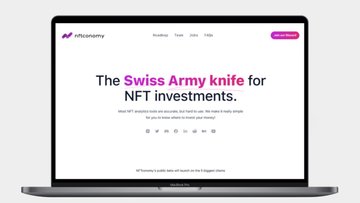Building NFTconomy: A Comprehensive Web3 Analytics Platform
Dive deep into the architecture and technology behind NFTconomy, a sophisticated data aggregation platform that processes millions of NFT transactions, social media signals, and market metrics in real-time using advanced ML algorithms.


The NFT space moves fast. Really fast. With billions of dollars flowing through digital marketplaces and new collections launching every day, investors and creators need sophisticated tools to make sense of the chaos. Enter NFTconomy – a comprehensive analytics platform that I helped architect to tackle one of Web3's biggest challenges: making sense of the data deluge.
The Problem: Information Overload in Web3
Traditional financial markets have Bloomberg terminals, Reuters feeds, and decades of established data infrastructure. The NFT space? Not so much. When NFTconomy was conceived, the landscape looked like this:
- Fragmented Data: Information scattered across OpenSea, Twitter, Discord, Reddit, and countless other platforms
- No Historical Context: Most platforms only showed current snapshots, not historical trends
- Manual Analysis: Investors had to cobble together insights from dozens of sources
- Social Signals Ignored: Community sentiment and engagement metrics were completely disconnected from trading data
The team at NFTconomy set out to build something different: the Swiss Army knife for NFT investments.
Architecture Overview: Building for Scale
NFTconomy's architecture is designed around one core principle: real-time data processing at massive scale. The platform processes over 32 million data points and serves analytics on 1.89 million NFTs across multiple blockchains.
The Technology Stack
// Core Architecture Components
const NFTCONOMY_STACK = {
// Data Layer
databases: ['MongoDB', 'Redis'],
// Backend Services
api: 'Express.js + TypeScript',
scrapers: 'Node.js + Python',
ml: 'Python + XGBoost + scikit-learn',
// Frontend Applications
web: 'Next.js + React + TypeScript',
chains: ['Ethereum', 'Neo', 'Cardano'],
// External APIs
integrations: ['OpenSea API', 'Twitter API v2', 'Reddit API', 'Alchemy API', 'Google Trends API']
};
Data Infrastructure: The Foundation
MongoDB as the Central Data Store
At the heart of NFTconomy lies a sophisticated MongoDB setup that handles multiple collections optimized for different query patterns:
// Core Data Collections
const collections = {
collections: {
// NFT collection metadata
fields: ['slug', 'name', 'categories', 'total_supply', 'image_url'],
indexes: ['slug', 'categories', 'created_date']
},
opensea_events: {
// All marketplace transactions
fields: ['slug', 'event_type', 'total_price', 'token_id', 'created_date'],
indexes: ['slug', 'event_type', 'created_date'],
volume: '23M+ transactions'
},
tweets: {
// Twitter sentiment & engagement data
fields: ['slug', 'sentiment', 'like_count', 'retweet_count'],
volume: '3M+ data points'
},
reddit_posts: {
// Reddit community signals
fields: ['slug', 'score', 'num_comments', 'sentiment'],
realtime: true
},
transfers: {
// On-chain transfer events
fields: ['slug', 'from_address', 'to_address', 'block_timestamp'],
whale_tracking: true
}
};
Real-Time Data Aggregation
The platform's aggregation pipelines are where the magic happens. Here's a simplified version of how NFTconomy calculates collection rankings with multi-dimensional scoring:
const weightage = {
volume: 1,
holders: 0.2,
buyers: 1,
sellers: -0.2,
no_of_transfers: 0.8,
twitter_engagement: 0.8,
reddit_engagement: 0.8,
floor_price: 1,
avg_price: 1,
min_price: 1,
max_price: 1,
no_of_sales: 1.1,
liquidity: 1,
market_cap: 1
};
// Complex aggregation pipeline combining multiple data sources
const collections = await db
.collection('collections')
.aggregate([
// Join Twitter engagement metrics
{
$facet: {
twitter_engagement: [
{
$lookup: {
from: 'tweets',
localField: 'slug',
foreignField: 'slug',
pipeline: [
{
$project: {
like_count: 1,
retweet_count: 1
}
}
]
}
},
{
$group: {
_id: '$slug',
avg_likes: { $avg: '$tweets.like_count' },
avg_retweet: { $avg: '$tweets.retweet_count' }
}
}
],
// Calculate trading volume metrics
volume_all: [
{
$lookup: {
from: 'opensea_events',
localField: 'slug',
foreignField: 'slug',
pipeline: [
{
$match: {
event_type: 'successful',
total_price: { $ne: '0' }
}
}
]
}
},
{
$group: {
_id: '$slug',
volume_all: {
$sum: {
$divide: [
{ $convert: { input: '$events.total_price', to: 'double' } },
1000000000000000000 // Convert from wei
]
}
}
}
}
]
}
}
])
.toArray();
Advanced Scrapers: Multi-Platform Data Collection
Twitter Intelligence
NFTconomy's Twitter scraper is a sophisticated system that handles API rate limiting across 6 different API keys and implements sentiment analysis using the VADER algorithm:
// Real-time sentiment analysis
let sentiment = vader.SentimentIntensityAnalyzer.polarity_scores(result.data.data[b].text);
let sentimentScore = 0;
if (sentiment.pos > sentiment.neg) {
sentimentScore = 1;
}
if (sentiment.pos < sentiment.neg) {
sentimentScore = -1;
}
if (sentiment.neu > sentiment.neg && sentiment.neu > sentiment.pos) {
sentimentScore = 0;
}
// Store comprehensive tweet data
dump.push({
slug: twitter_username_array[i].slug,
post_text: result.data.data[b].text,
author_name: author_name,
retweet_count: result.data.data[b].public_metrics.retweet_count,
like_count: result.data.data[b].public_metrics.like_count,
sentiment: sentimentScore
});
Reddit Community Tracking
The Reddit scraper uses the Snoowrap library to monitor community engagement across project-specific subreddits:
// Process Reddit posts with sentiment analysis
data.forEach((element: any) => {
let sentiment;
if (element['selftext']) {
sentiment = vader.SentimentIntensityAnalyzer.polarity_scores(element['selftext']);
} else {
sentiment = vader.SentimentIntensityAnalyzer.polarity_scores(element['title']);
}
newData.push({
slug,
text: element['selftext'],
title: element['title'],
score: element['score'],
num_comments: element['num_comments'],
sentiment: sentimentScore
});
});
Machine Learning: Predictive Analytics Engine
XGBoost for Time Series Prediction
NFTconomy's ML API leverages XGBoost to predict various metrics including social engagement, market cap, and transfer volume. Here's how the Reddit engagement prediction model works:
def create_features(df, label=None):
df['date'] = df.index
df['hour'] = df['date'].dt.hour
df['dayofweek'] = df['date'].dt.dayofweek
df['quarter'] = df['date'].dt.quarter
df['month'] = df['date'].dt.month
df['year'] = df['date'].dt.year
df['dayofyear'] = df['date'].dt.dayofyear
df['dayofmonth'] = df['date'].dt.day
df['weekofyear'] = df['date'].dt.weekofyear
X = df[['hour','dayofweek','quarter','month','year',
'dayofyear','dayofmonth','weekofyear']]
if label:
y = df[label].astype('float32')
return X, y
return X
# Train XGBoost model
reg = xgb.XGBRegressor(
n_estimators=1000,
max_leaves=1000,
base_score=0.5
)
reg.fit(X_train, y_train,
eval_set=[(X_train, y_train), (X_test, y_test)],
early_stopping_rounds=50,
verbose=False
)
Model Evaluation & Performance Tracking
The platform tracks model performance using comprehensive evaluation metrics:
def getEvalMat(actual, predicted):
MAE = mean_absolute_error(y_true=actual, y_pred=predicted)
MSE = mean_squared_error(y_true=actual, y_pred=predicted)
RMSE = mean_squared_error(y_true=actual, y_pred=predicted, squared=False)
R2_score = r2_score(y_true=actual, y_pred=predicted)
MSLR = mean_squared_log_error(y_true=actual, y_pred=predicted)
eval_mat = {
"Mean Absolute Error": MAE,
"Mean Squared Error": MSE,
"Root Mean Squared Error": RMSE,
"R Squared": R2_score,
"Mean Squared Log Error": MSLR
}
return eval_mat
Frontend Architecture: Multi-Chain Support
Next.js Application Structure
NFTconomy features multiple frontend applications targeting different blockchain ecosystems:
- app-v2: General Web3 with RainbowKit wallet integration
- app-v3: Enhanced version with Sentry error tracking and Web3 React
- cardano-nft-analytics-fe-v1: Cardano-specific analytics
- neo-nft-analytics-fe-v1: Neo blockchain integration
Real-Time Search & Discovery
The platform's search functionality demonstrates the power of the underlying data infrastructure:
const triggerSearch = (e) => {
e.preventDefault();
console.log('Triggered Search');
history.push(`/search/collections?q=${SearchQuery}`);
};
// Hero section with advanced search
<div className="rounded-3xl border-[3px] border-gray-300 px-4 py-3 lg:px-6 dark:border-zinc-800">
<form onSubmit={triggerSearch} className="flex-1">
<label className="block text-xs font-medium text-gray-900 dark:text-zinc-400">
Search for anything related to NFTs
</label>
<input
type="text"
value={SearchQuery}
onChange={onSearchInputChange}
className="block w-full border-0 bg-transparent p-0 pt-3 text-gray-900 dark:text-white"
placeholder="E.g. Bored Ape Latest News"
/>
</form>
</div>;
Performance & Scale: Handling Millions of Data Points
Caching Strategy
NFTconomy implements Redis-based caching to handle the massive query load:
// API response caching with TTL
setCache(
uniqueKey(req),
JSON.stringify({
success: true,
data: collections
}),
1440 // 24 hour cache
);
Database Optimization
The platform uses sophisticated MongoDB aggregation pipelines that combine data from multiple collections efficiently:
- Indexed queries on high-cardinality fields like
slug,created_date,event_type - Compound indexes for complex filtering operations
- Faceted aggregations to compute multiple metrics in parallel
- Time-based sharding for historical data access patterns
Key Features & Capabilities
Advanced Analytics Dashboard
- Real-time collection rankings with multi-dimensional scoring
- Historical price trends and volume analysis
- Community sentiment tracking across platforms
- Whale activity monitoring and alerts
Social Intelligence
- Twitter engagement metrics with sentiment analysis
- Reddit community health scoring
- Google Trends integration for market interest
- Cross-platform correlation analysis
Machine Learning Models
- XGBoost-based price prediction models
- Social engagement forecasting
- Market cap trend analysis
- Transfer volume predictions
Multi-Chain Support
- Ethereum ecosystem (ERC-721, ERC-1155)
- Neo N3 blockchain integration
- Cardano native assets
- Cross-chain portfolio tracking
Results & Impact
Since launching, NFTconomy has achieved impressive metrics:
- 1.89M+ NFTs tracked and indexed
- 3M+ community data points processed
- 23M+ marketplace transactions recorded
- 264K+ whales recognized and tracked
- Sub-second query response times despite massive data volumes
Team & Scale
The platform was built by a distributed team of 23+ members across engineering, design, marketing, and operations, demonstrating how modern Web3 projects can scale globally from day one.
Technical Lessons Learned
1. Data Quality is Everything
In the Web3 space, data inconsistencies are rampant. Building robust data validation and cleanup pipelines was crucial for reliable analytics.
2. Real-Time vs. Batch Processing
Finding the right balance between real-time updates and batch processing for historical analysis required careful architecture decisions.
3. API Rate Limiting at Scale
Managing API quotas across Twitter, OpenSea, and other platforms required sophisticated request queuing and key rotation strategies.
4. Community Data is Predictive
One of the most valuable insights: social signals often precede price movements in NFT markets, making community tracking essential for predictive analytics.
The Future of NFT Analytics
NFTconomy represents a new generation of Web3 analytics platforms that go beyond simple price tracking. By combining:
- Multi-chain data aggregation
- Social sentiment analysis
- Machine learning predictions
- Real-time processing at scale
The platform demonstrates what's possible when you treat NFT data with the same sophistication as traditional financial markets.
What's Next?
The NFT analytics space is still evolving rapidly. Future developments might include:
- Cross-chain interoperability metrics
- DeFi protocol integration for yield tracking
- AI-powered investment recommendations
- Institutional-grade risk assessment tools
Conclusion
Building NFTconomy was an exercise in taming the chaos of Web3 data. The project showcases how modern data engineering techniques, combined with machine learning and thoughtful UX design, can create genuinely useful tools for navigating the complex world of digital assets.
The platform's architecture demonstrates several key principles for Web3 development:
- Start with data quality and build analytics on top
- Embrace multiple chains from the beginning
- Social signals matter as much as transaction data
- Real-time processing is table stakes for user experience
- Machine learning can provide genuine predictive value
For developers building in the Web3 analytics space, NFTconomy serves as a comprehensive example of what's possible when you combine sophisticated data engineering, multi-platform integration, and user-focused design into a cohesive platform.
The NFT market may be volatile, but the need for high-quality data and analytics will only continue to grow. Platforms like NFTconomy are laying the foundation for the next generation of Web3 financial infrastructure.
Interested in building similar data-intensive Web3 platforms? The key is starting with a solid foundation of real-time data ingestion, multi-source aggregation, and scalable analytics pipelines. The technology is mature – the opportunity is immense.
Subscribe to my newsletter
I occasionally write about engineering, books, and the intersection of technology and human nature. No spam, just thoughtful conversations.

Dive deep into the architecture and technology behind NFTconomy, a sophisticated data aggregation platform that processes millions of NFT transactions, social media signals, and market metrics in real-time using advanced ML algorithms.

A revolutionary web3 communication platform that bridges smart contract events with real-world notifications. Build automated workflows that trigger Discord messages, emails, and webhooks from blockchain activity.

A revolutionary Web3 platform leveraging prediction market primitives to transform fellowship selection and accountability. Built for ETHGlobal Bangkok hackathon with multi-chain smart contracts, real-time oracles, and community-driven decision making through skin-in-the-game mechanics.